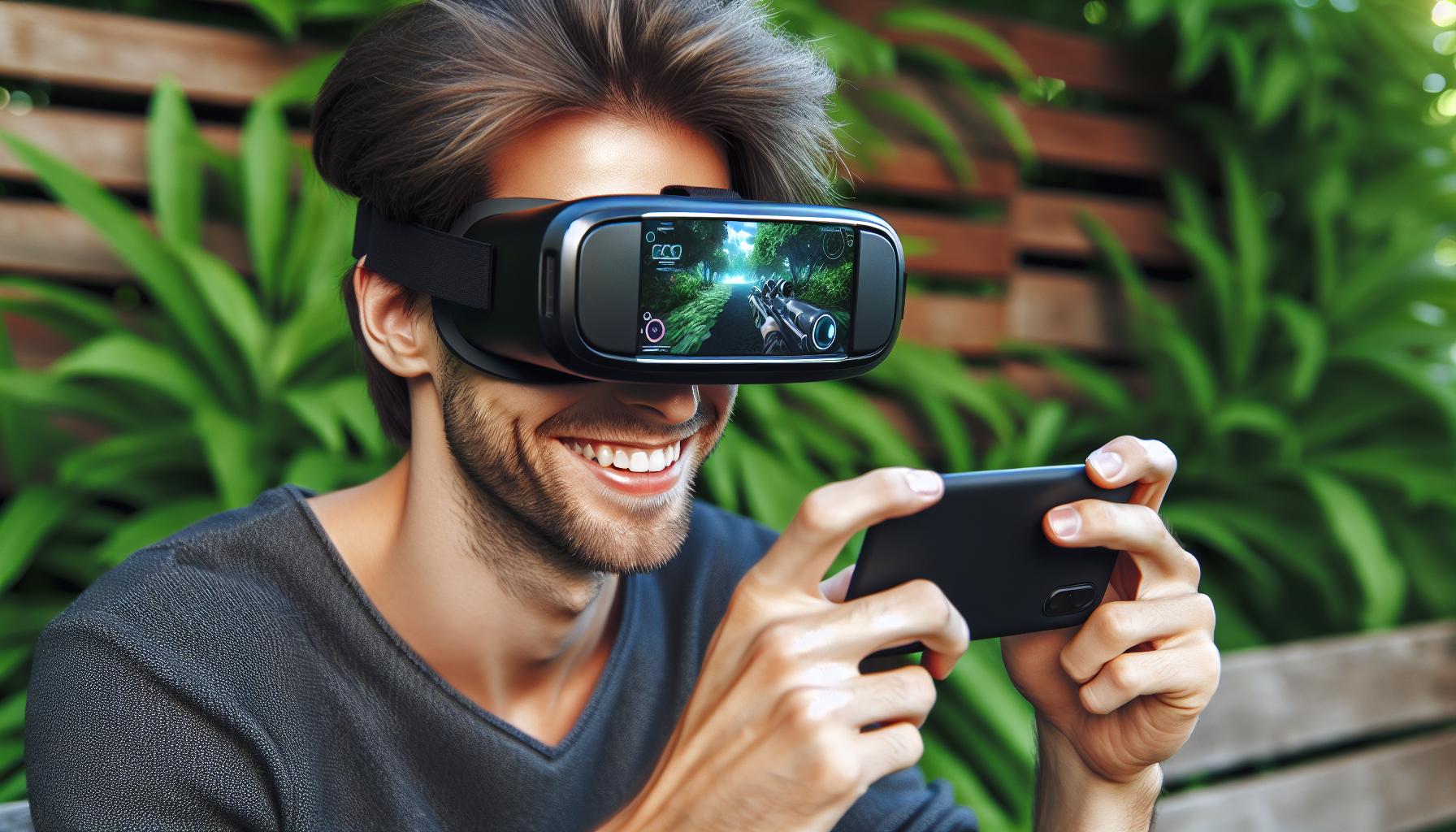Imagine strapping on a headset and stepping into a world where dragons roam your living room and aliens invade your backyard. Welcome to the augmented reality gaming market, where reality gets a much-needed upgrade! This booming industry is transforming how gamers interact with their favorite titles, blending the digital and physical realms in ways that make even the most imaginative sci-fi movies jealous.
Augmented Reality Gaming Market
The augmented reality (AR) gaming market is experiencing rapid growth, driven by advancements in technology and increasing consumer interest. The global AR gaming market is projected to reach $398 billion by 2025, growing at a compound annual growth rate of 73.7%. This remarkable growth is fueled by rising smartphone penetration, improved internet connectivity, and the integration of AR features in popular gaming platforms.
Major companies, including Niantic, Inc. and Snap Inc., lead the market with innovative game offerings that enhance user engagement. Popular titles such as Pokémon GO have demonstrated the market’s potential to blend digital experiences with real-world settings, attracting millions of players. Additionally, the expansion of social media platforms incorporating AR capabilities fosters further interest in immersive gaming experiences.
Consumer demographics indicate that younger audiences are the primary adopters of AR gaming. Individuals aged 18 to 34 represent a substantial share of users, making this age group a key focus for marketers. The demand for engaging and interactive content drives developers to create more sophisticated AR experiences that resonate with players.
Investments in research and development also play a crucial role in the market’s evolution. Developers continuously explore the potential of AR technology to enhance gameplay mechanics, ensuring players remain immersed in captivating storylines. The future of the AR gaming market appears bright as innovations continue to emerge, indicating a strong trajectory for growth in the coming years.
Collaboration among technology firms and gaming companies accelerates advancements in AR gaming. Partnerships enable access to cutting-edge tools and resources, further enriching the gaming landscape. As new entrants join the market, competition intensifies, leading to exciting developments that continue to reshape the gaming experience.
Key Trends Impacting The Market

Augmented reality gaming rapidly evolves, driven by key trends that reshape the landscape. Significant aspects include the growth in mobile gaming and advancements in AR technology.
Growth In Mobile Gaming
Mobile gaming fuels the augmented reality gaming market’s expansion. Revenue from mobile games reached $175 billion in 2021, underscoring their popularity. Younger audiences, especially those aged 18 to 34, prefer gaming on smartphones, which facilitates the integration of AR experiences. Many developers design games specifically for mobile platforms, enhancing accessibility and engagement. As smartphone penetration increases globally, the user base for AR gaming expands, leading to innovative game mechanics and immersive experiences.
Advancements In AR Technology
Recent advancements in AR technology significantly impact the gaming market. Improved hardware, such as more powerful processors and high-resolution displays, enhances gameplay experiences. Innovations in software development kits enable developers to create realistic and interactive elements seamlessly. Companies invest in artificial intelligence and machine learning to personalize gaming experiences further. Enhanced tracking abilities allow better interaction with real-world environments. As these technologies evolve, they pave the way for more captivating AR gaming experiences.
Major Players In The Market

The augmented reality gaming market hosts several influential companies driving innovation and expansion. Major players include Niantic, Inc. and Snap Inc., known for their pioneering titles like Pokémon GO.
Companies To Watch
Epic Games stands out with its Unreal Engine, providing powerful tools for AR game development. Unity Technologies also captures attention with robust creative solutions for immersive gaming experiences. Microsoft’s HoloLens offers unique mixed reality features, enriching gameplay with physical world interaction. Furthermore, Facebook’s Oculus aims to enhance social gaming through AR and virtual reality integration, shaping the industry’s future.
Market Share Analysis
Market share among leading companies reflects growth patterns within the AR gaming sector. Niantic, Inc. commands a significant portion, driven by its successful revenue model and community engagement. Snap Inc. follows closely, leveraging augmented reality features in its social media platform. Unity Technologies and Epic Games contribute notably, with their game development platforms gaining popularity. Recent statistics indicate that AR gaming will continue expanding, with expected dominance from these key players forming a robust competitive landscape.
Challenges Faced By The Market

The augmented reality gaming market encounters several challenges that may hinder its growth. Technical limitations and user adoption issues present significant barriers for developers and consumers alike.
Technical Limitations
Technical limitations affect the overall experience of augmented reality gaming. Devices often struggle with processing power, leading to lag or reduced performance. Additionally, many smartphones lack the advanced sensors required for seamless interactions in AR environments. Hardware fragmentation poses another challenge, as varying device capabilities can limit gameplay consistency. Developers must optimize games for diverse platforms, complicating the development process. Improved software solutions and hardware advancements are critical to bridging these technical gaps and creating immersive AR experiences.
User Adoption Issues
User adoption issues remain a significant hurdle within the AR gaming market. Many users face skepticism about augmented reality experiences, often questioning the long-term value of these games. Privacy concerns also arise, particularly regarding location data and personal information. Additionally, the learning curve associated with AR games can deter potential players. Simplifying the onboarding process and enhancing usability is essential. Effective marketing strategies highlighting game benefits can help alleviate user doubts and attract a broader audience. Addressing these concerns is crucial for driving widespread acceptance and participation in AR gaming.
Future Prospects Of Augmented Reality Gaming Market
Growth in augmented reality (AR) gaming promises significant advancements and opportunities. The market, expected to reach $398 billion by 2025, displays a compound annual growth rate of 73.7%. This rapid expansion stems from various factors, including technological advancements and increasing smartphone usage.
Investments play a crucial role in shaping the future of the industry. Developers are focusing on enhancing gameplay mechanics and creating more engaging content. Younger audiences, specifically those aged 18 to 34, drive demand, leading to more interactive experiences.
Emerging trends present exciting prospects for AR gaming. Mobile gaming continues to be a significant contributor, with revenue at $175 billion in 2021. This segment captures the attention of younger players who favor on-the-go gaming, enhancing accessibility and engagement.
Advancements in AR technology, such as improved hardware and software, foster realistic interactions. Investments in artificial intelligence and machine learning personalize gameplay experiences, making games more immersive. Better tracking systems empower players to engage with their environments seamlessly.
Key industry players, like Niantic, Inc. and Snap Inc., remain at the forefront of innovation. Titles such as Pokémon GO exemplify successful AR integration. Companies such as Epic Games and Unity Technologies provide powerful tools, while Microsoft’s HoloLens and Facebook’s Oculus enhance mixed reality gaming.
Challenges also persist, influencing the market’s trajectory. Technical limitations, including processing power and hardware diversity, hinder development. Moreover, user adoption remains a concern due to privacy issues and skepticism toward AR. Addressing these barriers is crucial for broader acceptance and sustained growth in the AR gaming sector.
Remarkable Evolution
The augmented reality gaming market stands on the brink of remarkable evolution. With its potential to transform traditional gaming experiences, it’s no wonder that both developers and players are eager to embrace this technology. As investments pour in and technological advancements continue, the opportunities for immersive gameplay are limitless.
While challenges exist, the focus on creating engaging content and simplifying user experiences will pave the way for broader adoption. The future is bright for AR gaming, with a promising trajectory that suggests it will play a significant role in the entertainment landscape for years to come.

